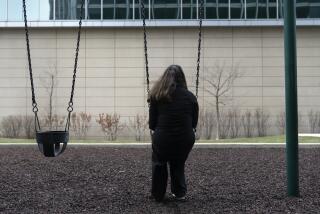Depression: When It’s More Than Just ‘the Blues’ : Mental illness: The disease has become so prevalent that experts call it ‘the common cold’ of psychiatric disorders.
- Share via
An estimated 14.9 million American adults will suffer from some form of depression during their lives.
The disease has become so prevalent that experts call it “the common cold of mental illness.” But adults aren’t the only victims; some researchers believe that up to 4.5% of teen-agers and 2% of all children under 12 may suffer from the disease.
Over the years, doctors have identified several distinct types of the disorder, although some people suffer from more than one depressive illness. Major depression, the most common form, will affect more than 10 million people at some point. It’s often characterized by constant fatigue, weight and sleep disturbances and persistent feelings of worthlessness that may result in suicidal thoughts. Victims frequently lose interest in pleasurable activities. Seasonal affective disorder (SAD), a condition most often caused by a lack of sunlight, is thought to alter brain chemistry and trigger depression. It plagues at least 10 million people, many of whom may suffer from other types of depression too, says Dr. Norman E. Rosenthal, author of “Seasons of the Mind: Why You Get the Winter Blues” (Bantam).
The 5.9 million Americans who have dysthymia (chronic depression) report many of the same symptoms but in a milder form; suicidal inclinations are less frequent. But if symptoms are milder, chronic depression often lasts longer--at least two years, contrasted with major depression, which typically, but not always, abates within six months. Manic depression--characterized by alternating bouts of depression and elation--affects about 1.4 million people in the United States. Manic depressives feel exhausted and tireless by turns; in the manic phase, they may behave impulsively and destructively.
But although an estimated 80% of depression sufferers can be treated effectively, only one-third actually receive any kind of therapy. “Two-thirds are living in misery, subject to marital disharmony, job loss, even suicide,” says Dr. Lewis L. Judd, former director of the National Institute of Mental Health.
While some victims may not have access to treatment, thousands simply do not recognize that help is available.
Experts say that although gender, age and marital status are contributing factors, a family history of the illness is one of the greatest risk factors for depression. Children of a depressed parent may be two to three times more likely than others to become depressed at some point. Although evidence suggests that the parents’ genetic makeup helps determine a child’s vulnerability to developing depression, the environment that parents create is also believed to play an important role.
Depressed children experience many of the same symptoms as adults, including sadness, fatigue and sleep disturbances. In many cases, children may feel hopeless, even suicidal. The condition in the young is often overlooked, however, especially when symptoms are mixed with such other behaviors as hyperactivity or delinquency. Treatment for childhood depression often consists of medication, frequently combined with family or individual therapy.
Whatever its cause, there is as yet no way to prevent an initial episode of depression. However, recurrences within a two-year period, which plague as many as 40% of all sufferers, can often be prevented or reduced.
Treatment is largely determined by the type of disorder. Victims of SAD can often benefit from various options, including light therapy, which involves sitting in front of a special bank of bright lights, sometimes in combination with psychotherapy and antidepressants. Victims of major depression are often given antidepressants.
Jolting people out of depression with electroconvulsive therapy was often used in the past and is still used today in the most severe cases: patients who cannot function at all, who are likely to kill themselves or who are delusional or unresponsive to drugs. Other methods of treatment have been expanded with short-term psychotherapies, especially cognitive and interpersonal therapy.
Despite these advances, researchers say that there is no magical treatment for depression; different methods work for different people, and many patients will need both medication and some brand of psychotherapy.






